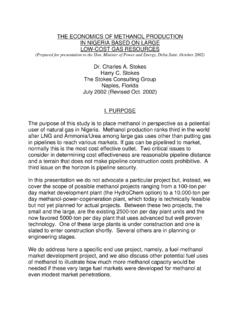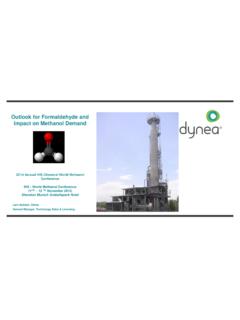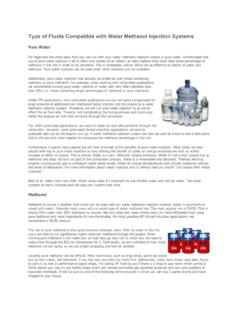Transcription of THE ECONOMICS OF METHANOL PRODUCTION - Project Gaia
1 THE ECONOMICS OF METHANOL PRODUCTION IN NIGERIA BASED ON LARGE LOW-COST GAS RESOURCES (Prepared for presentation to the Hon. Minister of Power and Energy, Delta State, October 2002) Dr. Charles A. Stokes Harry C. Stokes The Stokes Consulting Group Naples, Florida July 2002 (Revised Oct. 2002) I. PURPOSE The purpose of this study is to place METHANOL in perspective as a potential user of natural gas in Nigeria. METHANOL PRODUCTION ranks third in the world after LNG and Ammonia/Urea among large gas uses other than putting gas in pipelines to reach various markets. If gas can be pipelined to market, normally this is the most cost effective outlet.
2 Two critical issues to consider in determining cost effectiveness are reasonable pipeline distance and a terrain that does not make pipeline construction costs prohibitive. A third issue on the horizon is pipeline security. In this presentation we do not advocate a particular Project but, instead, we cover the scope of possible METHANOL projects ranging from a 100-ton per day market development plant (the HydroChem option) to a 10,000-ton per day METHANOL -power-cogeneration plant, which today is technically feasible but not yet planned for actual projects. Between these two projects, the small and the large, are the existing 2500-ton per day plant units and the now favored 5000-ton per day plant that uses advanced but well proven technology.
3 One of these large plants is under construction and one is slated to enter construction shortly. Several others are in planning or engineering stages. We do address here a specific end use Project , namely, a fuel- METHANOL market development Project , and we also discuss other potential fuel uses of METHANOL to illustrate how much more METHANOL capacity would be needed if these very large fuel markets were developed for METHANOL at even modest market penetrations. II. BACKGROUND A. Historical The METHANOL industry is over a century old. Its history divides into roughly four eras. In the first, 1850 to 1920, METHANOL was made as a by-product of wood carbonization to make various wood-derived chemicals, with charcoal as a by-product.
4 In the second era, in the mid-1920s, the high-pressure synthesis of METHANOL from coal-derived gas (CO and H2) was discovered. Part way through this era, feed stock shifted from coal-derived synthesis gas to that made from cheap natural gas, with a consequent drastic reduction in manufacturing cost and a lowering of capital cost. The third era, starting mid-Twentieth Century, was ushered in by the low-pressure process reducing pressures from roughly 5000 psig to about 1000 psig. Plants became larger, capital costs came down and so did manufacturing costs. During this era plant sizes were constantly increased and a standard of about 2500 tons per day for a single line was finally reached.
5 Late in this period there developed a frenzy of effort to reduce the capital cost of plants by innovations in synthesis gas PRODUCTION , an effort that carried forward strongly into the next era. The fourth era, in which we are now, started near the end of the century and might be called the mega-plant era. During this era, every effort has been made to gain the ECONOMICS of scale by going to 5000 tons per day per line or even larger. Efforts to reduce capital in the synthesis gas end of PRODUCTION have accelerated. This era will see continued changes. The first 5000-ton per day lines are not yet on stream but one is about halfway through construction and several others are at various stages of planning and/or engineering.
6 We can Project the ECONOMICS of these new plants but we have yet to realize them. On the horizon, in our opinion, is yet another era in which two things will happen: (1) Major markets for METHANOL for energy uses will finally open up, after over 30 years of discussion and preliminary effort, 2 (2) We will see the advent of METHANOL /electrical-energy cogeneration plants. Already some large METHANOL plants have power to export. Synergisms exist between METHANOL PRODUCTION and power PRODUCTION . The famous Cool Water integrated coal gasification and combined cycle Project looked at the concept of making and storing METHANOL when all of the gas was not needed for power.
7 Another variant is integrations of gas reforming and combined cycle power generation that makes fuel grade METHANOL of slightly less purity than chemical grade METHANOL . Such a plant has yet to be built but all of the technology is proven and the necessary power generation equipment is available from General Electric. The main reason we stress this history is to show that METHANOL technology is still undergoing constant improvement with a result of continued cost reduction of METHANOL . This includes increasing line size, improving reforming to reduce capital and oxygen use (when combined reforming is used) and generally to reduce capital cost and overall PRODUCTION cost.
8 In some cases CO2 emissions per unit of product can be reduced. The goal of advanced METHANOL process-engineering designers is to bring the delivered-to-terminal cost of METHANOL on a Btu basis down to the level of LNG or below it. Some such designs have already been published. 1 The Btu costs referred to are delivered to a terminal. What is important in the final analysis is the Btu cost delivered to the customer. Here it must be remembered that the distributor can take METHANOL from a low-cost terminal with a gasoline truck and the consumer can take it away in a jerry can. LNG, held in a much more expensive terminal, must be regasified and delivered by pipeline to a large customer or a large group of customers whose consumption can justify the line, which itself will cost up to 1 million dollars per mile depending upon size and terrain.
9 What this brief excursion through history tells us is that we can start with raw material Btus, costing generally $ to $ per million, convert them to an easily transported liquid fuel, transport that fuel to market, have a highly superior fuel, always exactly the same because it is made of a single molecule, and do this today at a profit, for a cost of about $ per MM Btu. 1 Toyo Engineering Corporation (TEC) 3 Crude oil, when delivered at $25 per barrel, and which has to be further refined, represents in its finished fuels a raw material cost above $ per MM Btu even before O&M costs or capital charges on the refinery are considered.
10 On the horizon, waiting only for application, is proven technology that can reduce the delivered MM Btu level for METHANOL to about $ If combined with electrical energy PRODUCTION in even larger plants, the level could approach $ per MM Btu. However, new markets must be developed on today s level of cost, which, over the years, has averaged $ per MM Btu with occasional distress pricing as low as $ per MM Btu, the latter representing cost plus some return for the larger plants with cheap gas. The general direction of crude oil price is up, whereas most of the world s natural gas is priced independently of crude oil because otherwise it simply would not get to market.









